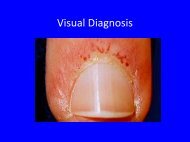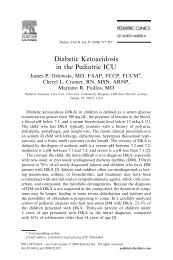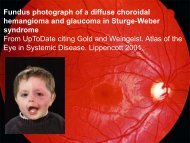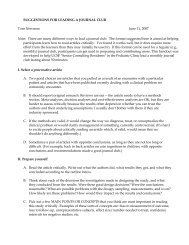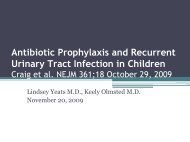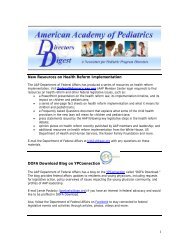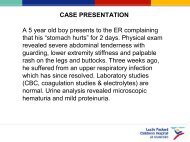DOI: 10.1542/peds.2009-1324 2010;125;e481-e488; originally ...
DOI: 10.1542/peds.2009-1324 2010;125;e481-e488; originally ...
DOI: 10.1542/peds.2009-1324 2010;125;e481-e488; originally ...
You also want an ePaper? Increase the reach of your titles
YUMPU automatically turns print PDFs into web optimized ePapers that Google loves.
Childhood obesity is a public health crisis<br />
of epidemic proportions throughout<br />
the world, with an estimated<br />
prevalence of 10% to 25%. 1–3 Cardiopulmonary<br />
resuscitation (CPR) and advanced<br />
life support for obese children<br />
experiencing cardiopulmonary arrest<br />
may be complicated by difficulties with<br />
the quality of CPR and problems with<br />
drug dosages. Specifically, the obese<br />
body habitus may pose distinct difficulties<br />
with airway management and effective<br />
chest compressions. In addition,<br />
pediatric advanced life support<br />
medications typically are administered<br />
on the basis of body weight<br />
but plasma concentrations of highly<br />
water-soluble medications may be<br />
substantially higher and potentially<br />
toxic in obese children when medications<br />
are dosed according to weight.<br />
Conversely, lipid-soluble medications<br />
may not reach adequate concentrations<br />
in obese children. 4<br />
The relationship of childhood obesity<br />
to survival after CPR is not well known.<br />
We evaluated the association between<br />
obesity and outcomes among children<br />
after in-hospital CPR in the American<br />
Heart Association National Registry of<br />
Cardiopulmonary Resuscitation (NRCPR),<br />
a large, multicenter registry of inhospital<br />
cardiac arrests. 5 We hypothesized<br />
that obese children would be less<br />
likely to survive to hospital discharge<br />
after in-hospital, pediatric CPR, compared<br />
with nonobese children.<br />
METHODS<br />
Study Design and Population<br />
The NRCPR is a prospective, multisite,<br />
in-hospital resuscitation registry<br />
sponsored by the American Heart Association,<br />
with voluntary, fee-based<br />
membership. At each participating institution,<br />
certified research coordinators<br />
abstract information about each<br />
CPR event from hospital medical<br />
records. The resulting database contains<br />
precisely defined variables de-<br />
e482 SRINIVASAN et al<br />
rived from the Utstein-style datareporting<br />
guidelines for cardiac<br />
arrest. 6,7 Case-study methods are used<br />
to evaluate data abstraction, the accuracy<br />
of entries, and compliance with<br />
operational definitions. The 6 major<br />
categories of variables are facility<br />
data, patient demographic data,<br />
preevent data, event data, outcome<br />
data, and quality-improvement data.<br />
The data are submitted securely, in<br />
compliance with Healthcare Information<br />
Portability and Accountability Act<br />
regulations, to a central data repository<br />
(Digital Innovation, Forest Hill,<br />
MD). The American Heart Association<br />
oversees the entire process of data<br />
collection, analysis, and reporting,<br />
through its national center staff, scientific<br />
advisory board, and executive database<br />
steering committee. The primary<br />
purpose of the NRCPR is quality<br />
improvement through monitoring of<br />
process-of-care standards, compliance,<br />
and benchmarking against national<br />
and peer standards. This study<br />
was approved by the institutional review<br />
board at the Children’s Hospital of<br />
Philadelphia.<br />
Data from 167 participating NRCPR<br />
hospitals that recorded cardiopulmonary<br />
arrests among patients 18<br />
years of age and provided 6 months<br />
of data from January 1, 2000, through<br />
July 31, 2004, were analyzed. All patients<br />
18 years of age who were<br />
treated with CPR at participating institutions<br />
were eligible for this study. According<br />
to NRCPR operational definitions,<br />
a CPR event was any event<br />
treated with chest compressions when<br />
a unit-wide or hospital-wide emergency<br />
response was activated, with<br />
the exclusion of events that commenced<br />
out of hospital and events involving<br />
newborn infants in the delivery<br />
suite. An index event was defined as<br />
the patient’s first CPR event during the<br />
hospitalization. Only index events were<br />
eligible for inclusion in the study. Ar-<br />
Downloaded from<br />
www.pediatrics.org by Alisa Arunamata on November 2, <strong>2010</strong><br />
rests among patients with “do not attempt<br />
resuscitation” orders and arrests<br />
that were resolved through<br />
implantable cardioverter-defibrillator<br />
shocks also were excluded.<br />
The NRCPR does not collect data on<br />
the height or length of subjects. Therefore,<br />
BMI values were calculated on the<br />
basis of median height-for-age values<br />
adjusted for gender, by using World<br />
Health Organization Anthro 2.0.4 and<br />
Anthroplus 1.0.2 software (World<br />
Health Organization, Geneva, Switzerland).<br />
BMI-for-age percentiles and weightfor-length<br />
percentiles, with corresponding<br />
z scores, were computed as<br />
appropriate. 8,9 Weight-for-length percentiles<br />
are a well-established growth<br />
standard for children 2 years of<br />
age, 8 whereas BMI-for-age percentiles<br />
are considered accurate to describe<br />
growth for children 2 years of age. 9<br />
Children were classified as obese<br />
(95th weight-for-length percentile if<br />
2 years of age or 95th BMI-for-age<br />
percentile if 2 years of age) or underweight<br />
(5th weight-for-length<br />
percentile if 2 years of age or 5th<br />
BMI-for-age percentile if 2 years of<br />
age), with adjustment for gender, on<br />
the basis of reference data collected<br />
by the World Health Organization. 10<br />
The prospectively selected, primary<br />
outcome measure was survival to<br />
hospital discharge. 6,7 Secondary outcome<br />
measures included survival of<br />
event (defined as return of spontaneous<br />
circulation for 20 minutes)<br />
and survival with favorable neurologic<br />
outcome. The neurologic outcome<br />
was determined according to<br />
the Pediatric Cerebral Performance<br />
Category scale, in which category 1<br />
represents a normal neurologic<br />
state, 2 mild disability, 3 moderate<br />
disability, 4 severe disability, 5 coma<br />
or vegetative state, and 6 death. 11,12<br />
Neurologic status before the arrest<br />
and at discharge was determined<br />
through chart review. A favorable



